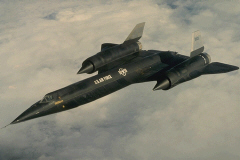SR71 Blackbird Design
I believe I can truly say that everything on the aircraft, from rivets and fluids,
up through materials and power plants had to be invented from scratch.
Clarence L. 'Kelly' Johnson (from a presentation to an AIAA Aircraft and Design
Operations Meeting.)
To say that the Blackbird is the product of design genius is an understatement...and not
quite accurate. The Blackbird is the product of the collective design genius of Lockheed's
famous "Skunk Works", the Advanced Development Projects Group, which gave birth to
the U·2 and the F·104, among other notable designs. Though the Skunk Works has en-
Joyed a reputation for innovation and accomplishment, they have not received half the
credit due them for their work on the Blackbird. That has been due to the secrecy surroun-
ding it's development and operational use.
In this age of high speed computers, capable of sophisticated design verification pro-
[ections, it is sometimes forgotten that the Skunk Works had to develop the Blackbird
with the tool of the pre-computer age ..... the slide rule. It was a tlrne-consurninq, expen-
sive, and sometimes exasperating method of pioneering. The fact that the Blackbird is
still the only airplane in the world capable of sustained speeds in excess of Mach 3 plus,
at altitudes of 85,000 feet or more is a tribute to the perseverance and creative genius of
Kelly Johnson and his hand-plcked Skunk Works team.
The design configuration of the Blackbird is a modified, tailless delta, with blended tor-
ward wing, called a chine. The chine acts as a fixed canard and the lift it produces at
cruise speeds reduces the forward fuselage bending moment to half and decreases drag.
The effective integration of the blended-body into the Blackbird is most evident by the
design modifications that must be made when the integrity of the design is interrupted.
For instance, incorporation of the radome housing the ASG·18 fire control radar in the
YF·12, which resulted in cut-back of the chine, necessitated addition of three ventral fins
to ensure that directional stability was maintained at high speed. The second, raised,
cockpit of the SR·71 B trainer required addition of two ventral fins for the same reason.
The high temperatures of Mach three plus flight, endured for long periods of time, were
the source of a large percentage of the design difficulties. The first assumption made in
designing a high speed anything is that you need as smooth a surface as possible to
reduce drag. But when heat was applied to smooth wing panels, they behaved like potato
chips. Eventually the chordwise corrugations that are such a recognizable feature of the
Blackbirds were added. Not only do they add strength and stability to the wing, they also
provide additional surface to radiate heat, with very little penalty in drag.
The conical camber incorporated in the leading edge of the outboard wing sections
reduce bending moment and torsion. The vertical stablizers are all moving. Conventional
rudders were considered, but found wanting because they lacked the authority for direc-
tional control in a single engine situation. The all-rnovinq surfaces are two and a half
times more effective than conventional rudders, and require less deflection, which means
less drag. They are canted inward at 15 degrees, and have a maximum movement of ± 20
degrees. A benefit of the inward-canted verticals is reduction of the rolling moment due to
sideslip and vertical deflection. This is evident at both ends of the speed spectrum. Their
effectiveness is further attested to by the Blackbird's ability to handle cross winds of up
to 35 knots at 90 degrees to runway heading.
Wind tunnel testing revealed that there was no appreciable advantage to incorporating
flaps or leading edge devices to the basic design. The large wing area generates a healthy
ground·effect cushion as it approaches the runway, making slick landings easy. Four
elevon surfaces, two outboard of the nacelles, and two inboard, act as elevators and
ailerons. Aileron deflection is ± 12 degrees.
At Mach three plus, exagerated control movements are likely to cause dramatic,
possibly catastrophic, changes in attitude. At the Blackbird's operating altitude, air densl-
 |
| www.sr-71.org |
The "A·11" announced by LBJ, which was in reality the AMI, later designated YF·12A.
First publicity photos showed the YF·12s in their CIA (mostly natural metal, ala A·12)
finishes. (USAF)
Kelly Johnson, head of Lockheed's advanced development projects (Skunk Works) during
the development of the Blackbird. Johnson joined Lockheed in 1933 as a tool designer,
and rose to the position of Chief Research Engineer by 1938. His famous projects include
the P·38, F·80, F·104, U·2, and the Blackbird. He was photographed with the number three
YF·12A shortly after it was announced to the public in 1964. (Lockheed)
-
No comments:
Post a Comment